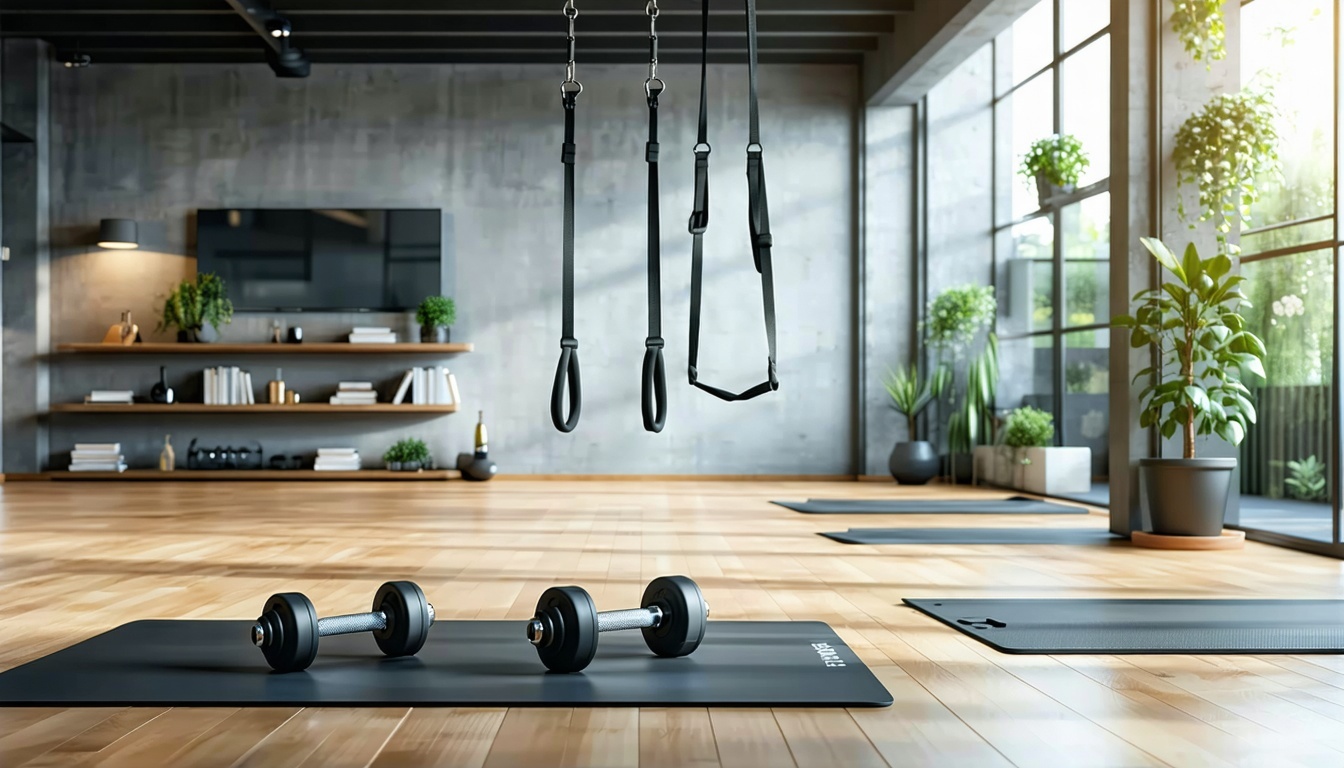Strength Training for the Time-Starved: Building Muscle in Minimal Time
Let's address the elephant in the conference room: you want to be strong, but you don't have three hours a day to spend grunting in a gym like some sort of professional bodybuilder. Between client calls, project deadlines, and family obligations, the idea of dedicating 90 minutes to bicep curls and bench pressing feels about as realistic as taking a three-hour lunch break.
Here's where traditional strength training advice has been leading you astray: you don't need to live in the gym to build impressive muscle and strength. In fact, some of the most effective strength training happens in focused, efficient sessions that respect your time constraints while delivering serious results.
Welcome to the world of time-efficient strength training, where strategic programming meets busy schedules, and where 20-30 minutes of focused effort can outperform hours of unfocused gym wandering. This isn't about settling for "good enough" – it's about discovering that smart training beats long training every single time.
The Science of Efficient Strength Training
Before we dive into the muscle-building specifics, let's demolish some myths about what it actually takes to build strength and muscle. The fitness industry has convinced us that more is always better, but science tells a different story.
Research published in the Journal of Strength and Conditioning Research found that training sessions lasting 45-60 minutes produced the same strength gains as sessions lasting 90+ minutes. The key factor wasn't duration – it was intensity and progressive overload.
A landmark study in the European Journal of Applied Physiology compared high-volume training (multiple sets, long workouts) with high-intensity training (fewer sets, shorter workouts) over 12 weeks. The results were eye-opening: both groups achieved similar strength gains, but the high-intensity group spent 40% less time training.
The magic happens through several key principles that make efficient strength training not just possible, but often superior to traditional approaches:
Progressive Overload: The Non-Negotiable Principle
Your muscles adapt to stress by becoming stronger. Progressive overload – gradually increasing the challenge over time – is the fundamental driver of strength gains. This can be achieved through increased weight, more repetitions, additional sets, or improved exercise difficulty.
The beauty of progressive overload is that it doesn't require massive time investments. A muscle doesn't care if you spent three hours in the gym – it only cares that you challenged it beyond its current capacity.
Compound Movement Efficiency
Compound exercises work multiple muscle groups simultaneously, providing maximum muscle-building stimulus in minimum time. A squat works your quads, glutes, hamstrings, core, and stabilizing muscles all at once. Compare that to leg extensions, which only work your quads, and the efficiency advantage becomes clear.
Time Under Tension
Muscle growth is stimulated by the total time your muscles spend under tension, not the total time you spend in the gym. A focused 20-minute session with high time under tension can be more effective than an hour of rest-heavy, low-intensity training.
Recovery Optimization
Strength gains happen during recovery, not during training. Shorter, more intense sessions often allow for better recovery, leading to more consistent training and faster progress.
The Busy Professional's Strength Training Philosophy
Effective strength training for time-starved professionals requires a fundamental shift in mindset from traditional gym culture approaches.
Quality Over Quantity
Every minute of your workout should serve a purpose. No time for Instagram scrolling, extended rest periods, or inefficient exercise selection. When time is limited, every rep counts.
Compound Movement Priority
Focus on exercises that work multiple muscle groups simultaneously. Squats, deadlifts, push-ups, pull-ups, and their variations should form the foundation of your routine.
Progressive Overload Focus
Track your progress religiously. Whether it's adding weight, increasing reps, or progressing to more challenging exercise variations, every workout should challenge you beyond your previous capacity.
Consistency Over Perfection
A consistent 20-minute routine performed three times per week will outperform a perfect 90-minute routine that you can only manage once per week. Consistency is the secret weapon of busy professionals.
The Complete Time-Efficient Strength Training System
Here's your comprehensive strength training system designed specifically for busy professionals who want serious results without serious time commitments.
The 20-Minute Power Session
Perfect for lunch breaks or early morning sessions when you need maximum results in minimum time.
Structure: 4 exercises, 3 sets each, minimal rest periods
Warm-Up (3 minutes):
- Arm circles and shoulder rolls: 30 seconds
- Leg swings and hip circles: 30 seconds
- Bodyweight squats: 30 seconds
- Push-ups (easy pace): 30 seconds
- High knees and butt kicks: 30 seconds
- Dynamic stretching: 30 seconds
Main Workout (15 minutes):
Superset 1 (7.5 minutes):
- Exercise A: Bodyweight Squats (or Goblet Squats)
3 sets of 12-15 reps
Focus on depth and control - Exercise B: Push-Ups (or Incline Push-Ups)
3 sets of 8-12 reps
Maintain perfect form throughout - Rest: 60 seconds between supersets
Superset 2 (7.5 minutes):
- Exercise C: Single-Leg Deadlifts (or Romanian Deadlifts)
3 sets of 8-10 per leg
Focus on hip hinge movement - Exercise D: Pike Push-Ups (or Handstand Progressions)
3 sets of 6-10 reps
Build shoulder and core strength - Rest: 60 seconds between supersets
Cool-Down (2 minutes):
- Hip flexor stretch: 30 seconds each leg
- Shoulder stretch: 30 seconds
- Deep breathing: 30 seconds
Progression Strategy:
- Week 1-2: Master form and establish baseline
- Week 3-4: Increase reps or add difficulty
- Week 5-6: Add resistance or progress to harder variations
- Week 7+: Continue progressive overload
The 30-Minute Strength Builder
When you have a bit more time for a comprehensive strength session.
Structure: 6 exercises, 3-4 sets each, strategic rest periods
Dynamic Warm-Up (5 minutes):
- Joint mobility sequence: 2 minutes
- Activation exercises: 2 minutes
- Movement preparation: 1 minute
Main Workout (22 minutes):
Block 1: Lower Body Power (8 minutes)
- Exercise 1: Squat Variations
4 sets of 8-12 reps
Progress from bodyweight to weighted - Exercise 2: Single-Leg Movements
3 sets of 6-10 per leg
Lunges, step-ups, or single-leg squats - Rest: 90 seconds between exercises
Block 2: Upper Body Strength (8 minutes)
- Exercise 3: Push Movement
4 sets of 6-12 reps
Push-ups, incline push-ups, or handstand progressions - Exercise 4: Pull Movement
3 sets of 5-10 reps
Pull-ups, rows, or resistance band pulls - Rest: 90 seconds between exercises
Block 3: Core Integration (6 minutes)
- Exercise 5: Plank Variations
3 sets of 30-60 seconds
Standard plank, side plank, or plank progressions - Exercise 6: Dynamic Core
3 sets of 10-15 reps
Mountain climbers, Russian twists, or dead bugs - Rest: 60 seconds between exercises
Mobility Cool-Down (3 minutes):
- Full body stretching sequence
- Focus on areas worked during session
- Deep breathing and relaxation
The 15-Minute Strength Snack
Ultra-efficient sessions for extremely busy days when something is better than nothing.
Structure: 3 exercises, 3 sets each, minimal rest
Quick Warm-Up (2 minutes):
- Arm swings and leg swings: 30 seconds
- Bodyweight squats: 30 seconds
- Push-ups (easy): 30 seconds
- High knees: 30 seconds
Tri-Set Circuit (11 minutes):
Perform all three exercises back-to-back, then rest. Repeat for 3 total rounds.
- Exercise 1: Squat Variation
10-15 reps
Bodyweight, jump, or weighted squats - Exercise 2: Push-Up Variation
8-12 reps
Standard, incline, or decline push-ups - Exercise 3: Core Movement
30-45 seconds
Plank hold, mountain climbers, or Russian twists - Rest: 90 seconds between rounds
Quick Cool-Down (2 minutes):
- Hip flexor stretch: 30 seconds each leg
- Shoulder stretch: 30 seconds
- Deep breathing: 30 seconds
Bodyweight Strength Progressions
Building serious strength without equipment requires understanding how to progress bodyweight exercises systematically.
Push-Up Progression Pathway
Master this progression to build impressive upper body strength:
Level 1: Incline Push-Ups
Hands elevated on desk, chair, or wall
Master 3 sets of 15 reps
Level 2: Knee Push-Ups
Modified push-ups from knees
Master 3 sets of 12 reps
Level 3: Standard Push-Ups
Full push-ups from toes
Master 3 sets of 10 reps
Level 4: Decline Push-Ups
Feet elevated on chair or bed
Master 3 sets of 8 reps
Level 5: Single-Arm Push-Ups
Ultimate bodyweight push challenge
Work toward 1 rep per arm
Squat Progression Pathway
Build powerful legs and glutes with this systematic progression:
Level 1: Assisted Squats
Hold onto chair or wall for support
Master 3 sets of 15 reps
Level 2: Bodyweight Squats
Full range of motion squats
Master 3 sets of 20 reps
Level 3: Jump Squats
Explosive power development
Master 3 sets of 12 reps
Level 4: Single-Leg Squats (Pistol Squats)
Ultimate leg strength challenge
Work toward 3 reps per leg
Level 5: Weighted Single-Leg Squats
Add resistance for continued progression
Progress weight gradually
Core Strength Progression
Develop rock-solid core strength with this systematic approach:
Level 1: Plank Hold
Standard plank position
Build to 60 seconds
Level 2: Side Plank
Lateral core strength
Build to 45 seconds each side
Level 3: Plank Variations
Plank up-downs, plank jacks
Master 3 sets of 10 reps
Level 4: Single-Arm/Leg Plank
Advanced stability challenge
Build to 30 seconds each variation
Level 5: Handstand Progression
Ultimate core and shoulder challenge
Work toward wall-supported handstand
Equipment-Minimal Strength Training
While bodyweight exercises form the foundation, a few simple pieces of equipment can dramatically expand your strength training options.
Resistance Bands: The Ultimate Portable Gym
Resistance bands provide variable resistance and take up virtually no space:
Upper Body Band Exercises:
- Band pull-aparts for rear delts and rhomboids
- Band rows for lats and middle traps
- Band chest press for pecs and triceps
- Band overhead press for shoulders
Lower Body Band Exercises:
- Band squats for added resistance
- Band lateral walks for glute activation
- Band deadlifts for posterior chain
- Band leg press for quad development
Band Workout Example (20 minutes):
- Band squats: 3 sets of 15
- Band rows: 3 sets of 12
- Band chest press: 3 sets of 12
- Band lateral walks: 3 sets of 10 each direction
- Band pull-aparts: 3 sets of 15
Suspension Trainer: Bodyweight Plus
Suspension trainers use your body weight and gravity for resistance:
Key Suspension Exercises:
- Suspension squats and lunges
- Suspension push-ups and chest press
- Suspension rows and reverse fly
- Suspension mountain climbers and pikes
Suspension Workout Example (25 minutes):
- Suspension squats: 4 sets of 12
- Suspension push-ups: 4 sets of 10
- Suspension rows: 4 sets of 10
- Suspension mountain climbers: 3 sets of 30 seconds
Dumbbells: Classic and Effective
A set of adjustable dumbbells provides unlimited progression potential:
Essential Dumbbell Exercises:
- Dumbbell squats and lunges
- Dumbbell chest press and flyes
- Dumbbell rows and reverse flyes
- Dumbbell shoulder press and lateral raises
Dumbbell Workout Example (30 minutes):
- Dumbbell squats: 4 sets of 10
- Dumbbell chest press: 4 sets of 8
- Dumbbell rows: 4 sets of 10
- Dumbbell shoulder press: 3 sets of 8
- Dumbbell lunges: 3 sets of 8 per leg
Strength Training Programming for Busy Professionals
Effective programming ensures consistent progress while fitting into demanding schedules.
The 3-Day Split
Perfect for busy professionals who can commit to three focused sessions per week:
Day 1: Lower Body Focus
- Squat variations: 4 sets
- Single-leg movements: 3 sets
- Hip hinge movements: 3 sets
- Core work: 2 sets
Day 2: Upper Body Push
- Push-up variations: 4 sets
- Overhead pressing: 3 sets
- Tricep work: 3 sets
- Core work: 2 sets
Day 3: Upper Body Pull + Full Body
- Pulling movements: 4 sets
- Bicep work: 3 sets
- Full-body movements: 3 sets
- Core work: 2 sets
The 2-Day Power Plan
For extremely busy periods when two quality sessions per week is the maximum:
Day 1: Full Body Strength
- Squat variation: 4 sets
- Push movement: 4 sets
- Pull movement: 3 sets
- Core work: 2 sets
Day 2: Full Body Power
- Jump/plyometric movement: 4 sets
- Push variation: 3 sets
- Single-leg movement: 3 sets
- Core work: 2 sets
The Daily Dose Approach
Brief daily sessions for those who prefer consistency over intensity:
- Monday: Push movements (10 minutes)
- Tuesday: Pull movements (10 minutes)
- Wednesday: Lower body (10 minutes)
- Thursday: Core and stability (10 minutes)
- Friday: Full body integration (15 minutes)
- Weekend: Longer session or active recovery
Tracking Progress and Staying Motivated
Consistent progress tracking is crucial for long-term success in strength training.
Key Metrics to Track
Performance Metrics:
- Repetitions completed at each exercise
- Time under tension for isometric holds
- Exercise progression level achieved
- Workout completion consistency
Subjective Metrics:
- Energy levels during and after workouts
- Perceived exertion during exercises
- Recovery time between sessions
- Overall strength and confidence feelings
Progress Tracking Tools
- Simple notebook or smartphone notes
- Fitness tracking apps with strength components
- Photo documentation of form improvements
- Video analysis of movement quality
Motivation Strategies
Short-Term Motivation:
- Set weekly rep or time goals
- Celebrate small improvements
- Track consistency streaks
- Focus on how you feel after workouts
Long-Term Motivation:
- Set monthly progression goals
- Take progress photos
- Notice functional strength improvements
- Connect strength gains to life activities
Nutrition for Strength Training Success
Proper nutrition supports your strength training efforts and maximizes results.
Protein Requirements
Adequate protein is crucial for muscle recovery and growth:
- Aim for 0.8-1.2 grams per pound of body weight daily
- Include protein in every meal
- Consider post-workout protein within 30 minutes
- Quality sources: lean meats, fish, eggs, dairy, legumes
Carbohydrate Timing
Strategic carbohydrate intake supports training performance:
- Include carbs 1-2 hours before training
- Post-workout carbs help with recovery
- Focus on whole food sources
- Adjust intake based on training intensity
Hydration and Recovery
- Maintain consistent hydration throughout the day
- Increase water intake on training days
- Consider electrolyte replacement for intense sessions
- Monitor urine color as hydration indicator
Common Strength Training Mistakes and Solutions
Avoid these common pitfalls that can derail your strength training progress.
Mistake: Neglecting Progressive Overload
Problem: Doing the same routine without increasing challenge.
Solution: Track your workouts and consistently challenge yourself with more reps, harder variations, or additional resistance.
Mistake: Inconsistent Training
Problem: Sporadic workout schedule that prevents adaptation.
Solution: Prioritize consistency over perfection. Two consistent workouts per week beat four sporadic ones.
Mistake: Poor Form Focus
Problem: Prioritizing quantity over quality of movement.
Solution: Master proper form before progressing. Quality reps build strength; sloppy reps build bad habits.
Mistake: Impatience with Results
Problem: Expecting immediate visible changes.
Solution: Focus on performance improvements and how you feel. Strength gains often precede visible muscle changes.
Mistake: All-or-Nothing Mentality
Problem: Skipping workouts because you can't do the "full" routine.
Solution: Embrace partial workouts. Ten minutes of strength training is infinitely better than zero minutes.
Advanced Strategies for Continued Progress
Once you've mastered the basics, these advanced strategies can help you continue progressing.
Periodization for Busy Schedules
Vary your training focus to prevent plateaus:
- Strength Phase: Lower reps, higher intensity
- Endurance Phase: Higher reps, moderate intensity
- Power Phase: Explosive movements, moderate reps
- Recovery Phase: Lower intensity, mobility focus
Time-Efficient Intensity Techniques
Supersets: Perform two exercises back-to-back without rest
Tri-sets: Three exercises performed consecutively
Drop sets: Reduce difficulty mid-set to continue training
Rest-pause: Brief rest periods within a single set
Seasonal Training Adaptations
Adjust your approach based on life demands:
- Busy seasons: Focus on maintenance with shorter sessions
- Lighter periods: Emphasize progression and skill development
- Travel periods: Bodyweight-only routines
- Stress periods: Lower intensity, stress-relief focus
The Long-Term Vision: Strength as a Lifestyle
The ultimate goal of time-efficient strength training isn't just building muscle – it's creating a sustainable approach to strength that enhances your life rather than complicating it.
Strength training for busy professionals should feel like an investment in your capability and confidence, not a burden on your schedule. When done correctly, it becomes a source of energy and stress relief rather than another item on your to-do list.
The habits you build through consistent strength training often extend beyond the gym. The discipline, goal-setting, and progressive improvement mindset that strength training develops can positively impact your professional life, relationships, and overall well-being.
Your Next Steps: From Weak Excuses to Real Strength
You now have everything you need to build impressive strength and muscle without sacrificing your career or family time. The science is clear, the methods are proven, and the only question remaining is: when will you start?
Here's your action plan:
This Week: Choose one of the 20-minute routines and complete it twice. Focus on learning the movements and establishing baseline performance.
Week 2: Add a third session and begin tracking your reps and progression. Notice how strength training affects your energy and mood.
Week 3-4: Establish a consistent schedule and begin progressing exercises. Focus on form quality and gradual improvement.
Month 2: Assess your progress and adjust your routine based on what's working. Consider adding equipment or progressing to more challenging variations.
Month 3 and Beyond: Develop a long-term strength training practice that becomes as automatic as your morning coffee routine.
Remember: you don't need hours to get strong. You just need consistency, progression, and the willingness to challenge yourself within the time you have available. Your strength journey starts with your next workout, not your next free weekend.
The time-starved can still get strong. Your transformation begins now.
Ready to explore more efficient fitness strategies? Check out our comprehensive guide to Quick & Effective Workouts for Busy Professionals, or try our Bodyweight Bootcamp for equipment-free muscle building.




